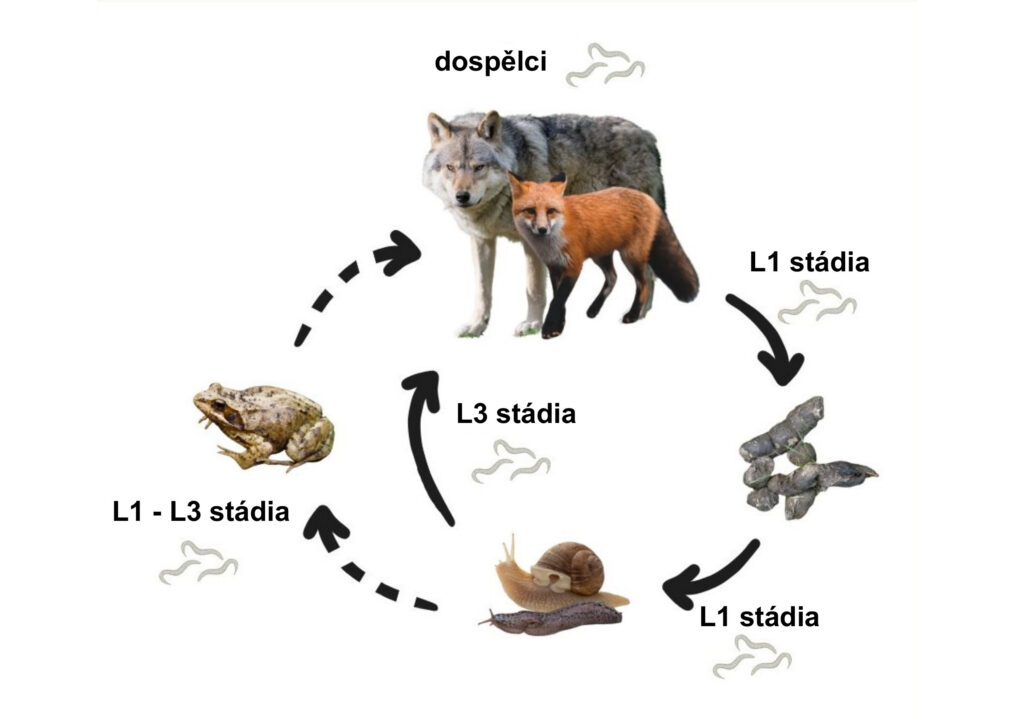
Poláková T., Juránková J., Daněk O. Genotypizace metastrongylidních hlístic z trusu volně žijících vlků obecných z NP Šumava. Genotyping of metastrongylid nematodes in fecal samples of wild grey wolves from Šumava National Park. Veterinářství 2025;75(3):134-137.
SOUHRN
S rozšiřující se vlčí populací v České republice roste i druhová diverzita parazitů, kteří mohou představovat potenciální riziko závažných onemocnění pro domácí psy. Jednou z těchto skupin parazitů jsou metastrongylidní hlístice, a to zejména druh Angiostrongylus vasorum. Ve spolupráci s NP Šumava byly v letech 2020 až 2023 sbírány vzorky trusu volně žijících vlků obecných, které byly následně vyšetřeny na Ústavu patologické morfologie a parazitologie Veterinární univerzity v Brně na přítomnost metastrongylidních hlístic. V součtu bylo vyšetřeno 357 vzorků s využitím sítování a PCR kombinované se sekvenací (COI a ITS2). Celkem bylo zaznamenáno 10 druhů plicnivek, z nichž pouze Crenosoma vulpis, detekovaná ve 4,6 % pozitivních vzorků, je prokazatelně parazitem vlků. U zbylých 95,4 % se jednalo o pasáž z kořisti. Angiostrongylus vasorum nebyl ve vlčím trusu detekován, ačkoliv byl jeho výskyt v ČR u vlků již dříve potvrzen. Oba zmíněné druhy by měly být součástí diferenciálních diagnóz respiračních a kardiovaskulárních onemocnění u domácích psů. V případě domácích psů je při diagnostice plicnivek také nutné zvažovat pseudoparazitismus (především v důsledku koprofágie) a pozitivní výsledek by měl být konzultován se zkušeným parazitologem nebo potvrzen molekulárními metodami.
SUMMARY
The expanding wolf population in the Czech Republic increases the overall diversity of parasite species and thus possibly also the risk of serious emerging parasitic diseases in domestic dogs. One of these parasite groups are metastrongylid nematodes, namely Angiostrongylus vasorum. In cooperation with the Šumava National Park, wolf fecal samples were collected from 2020 to 2023 and examined for the presence of metastrongylid nematodes at the Department of Pathology and Parasitology of the University of Veterinary Sciences Brno. A total of 357 samples were analyzed using the sieving method and subsequent PCR combined with sequencing (COI and ITS2). Ten lungworm species were detected, however, only Crenosoma vulpis, which was detected in 4.6% of the positive samples, is a known parasite of wolves. The remaining 95.4% were parasites of prey animals. Angiostrongylus vasorum was not detected in wolf feces, although its presence in wolves has already been confirmed in the Czech Republic. Therefore, A. vasorum and C. vulpis should be considered in the differential diagnosis of respiratory and cardiovascular diseases in domestic dogs. Furthermore, pseudoparasitism (mainly due to coprophagy) should always be considered in the diagnosis of lungworms in dogs and positive results need to be discussed with an experienced parasitologist or confirmed by molecular methods.*